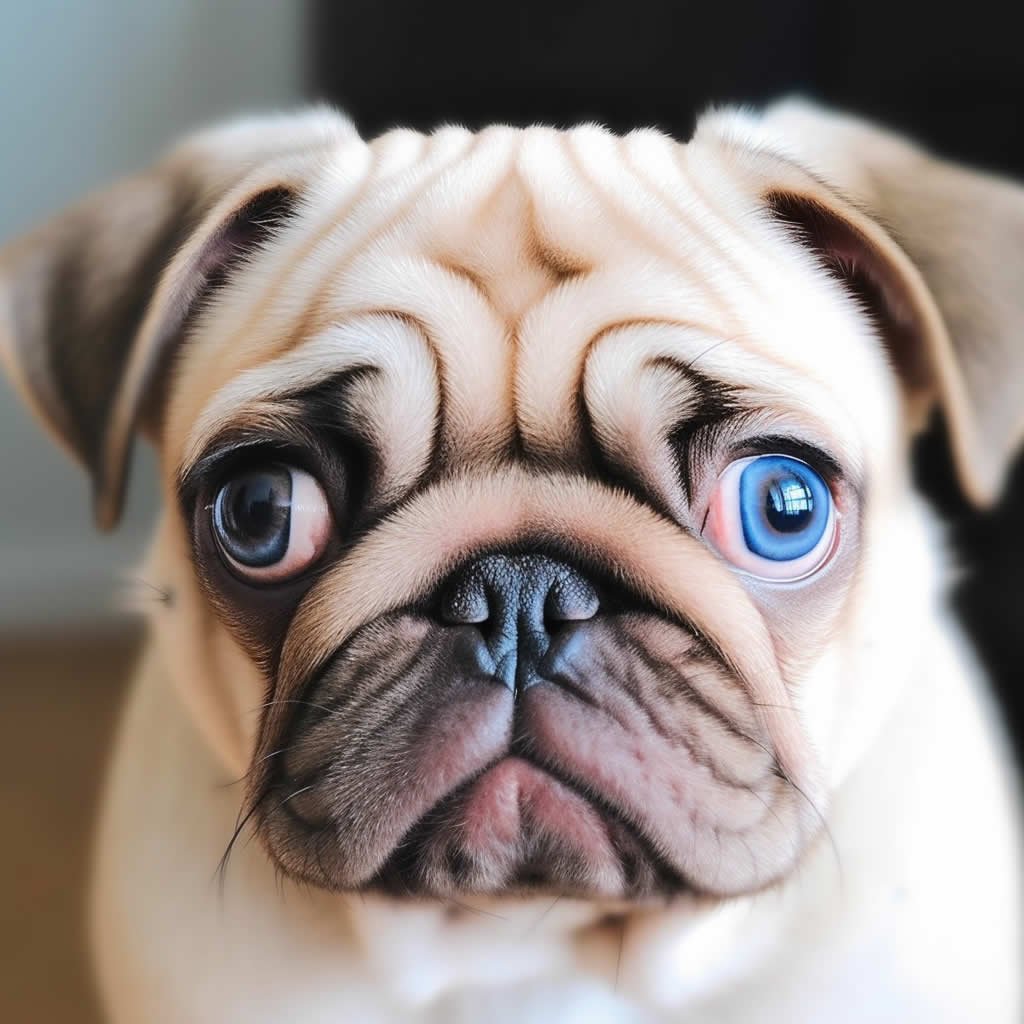Can Pugs Have Blue Eyes?
Introduction
Have you ever seen a cute pug and wondered if it’s even possible for this adorable breed to have blue eyes? The answer is yes, although very uncommon, some pugs can indeed have striking blue eyes!
In this blog post, we’ll dive into the fascinating world of Pug genetics and explore the reasons behind this occurrence, as well as the potential risks associated with these beautiful yet unusual peepers.

Table of Contents
Key Takeaways
- While it is rare, pugs can indeed have blue eyes due to genetic mutations or albinism.
- Blue-eyed pugs are at an increased risk of developing eye infections and even blindness due to the lack of melanin protection in their eyes.
- Selective breeding practices by some breeders can produce blue – eyed pugs, but potential pet owners should be aware of the health risks associated with this unique feature before making a decision.
- It’s important for pet owners to prioritise their furry friend’s health over aesthetics when considering breeding or adopting a blue-eyed pug.
The Possibility Of Pugs Having Blue Eyes
Pugs having blue eyes is a possibility, although it is a rare occurrence and not a natural eye colour for the breed.
Rarity Of Occurrence
As a seasoned pug enthusiast, I’ve marvelled at the unique appearance of these lovable pets. In my experience, blue-eyed pugs are incredibly rare and often catch the attention of fellow pet owners and breeders alike.
Among all the known eye colours in dogs, blue eyes remain a captivating and uncommon feature.
Interestingly, even though seeing a blue-eyed pug isn’t an everyday occurrence, it’s not entirely impossible either. Some breeders have managed to produce this exceptional trait through selective breeding practices that occasionally result in this striking phenotype being passed down among generations.
Natural Phenomenon
As a pug enthusiast, I’ve always been fascinated by the different quirks and characteristics these charming little dogs have. One such captivating trait is the possibility of having blue eyes – an exceptionally rare occurrence in pugs.
A lack of melanin is one factor that could lead to blue-eyed pugs. Melanin, responsible for pigmenting our furry friends’ coats and eyes, sometimes fails to provide enough pigmentation, resulting in lighter eye colours.
Another intriguing phenomenon is heterochromia – a condition where each of a dog’s eyes appears with different pigmentation levels or even entirely distinct hues! Embark scientists found a genetic variant linked to some dogs having captivating blue eyes too.
The Genetics And Causes Of Blue Eyes In Pugs
Blue eyes in pugs can be caused by genetic mutations or albinism, but the occurrence is rare.
Albinism
As a pug enthusiast, I’ve come across some fascinating facts about these adorable dogs. One aspect that you might find surprising is albinism in pugs. Albinism occurs when a dog can’t produce sufficient melanin, which is the pigment responsible for colour in their skin, hair, and eyes.
An interesting example I came across was an incredibly rare albino Pug who had light pink features along with light blue eyes. Although this pup was truly one-of-a-kind, it’s important to note that albino dogs may face specific health challenges due to their lack of pigmentation.
Their sensitive skin could lead to sunburns and other related issues if they’re not properly protected during sunny days outdoors.
Genetic Mutations
Genetic mutations are also known to cause blue eyes in pugs. These mutations can occur spontaneously or during breeding when certain genes get passed down.
It’s important to note that genetic mutations can also increase the risk of health problems associated with blue eyes. For example, dogs with the double merle gene (which occurs when two merle dogs are bred together) may have a higher likelihood of being deaf or blind.
The Risks Associated With Blue Eyes In Pugs
Blue eyes in pugs can increase their risk of blindness and eye infections due to the lack of melanin, which provides protection against harmful UV rays and other environmental factors.
Increased Risk Of Blindness And Eye Infections
As lovable as Pugs are, they come with some unique health challenges. One of the risks associated with blue eyes in Pugs is an increased chance of developing blindness and eye infections.
Sadly, about 50% of Pugs will experience varying degrees of pigmentary keratitis. This condition leads to vision impairment and even blindness if left untreated. Additionally, entropion is a hereditary condition that also affects some Pugs leading to chronic eye infections which may cause discomfort for your furry friend.
Conclusion
In conclusion, while it is rare for pugs to have blue eyes, it is certainly possible. Blue eyes can occur naturally as a result of genetic mutations or albinism. However, pug owners should be aware that blue-eyed pugs are at an increased risk of eye infections and blindness due to their flat faces.
FAQs:
1. Can pugs have blue eyes naturally?
No, pugs cannot have blue eyes naturally as the breed standard dictates that their eye colour should be dark brown or black. The presence of blue eyes may indicate a health issue in the dog.
2. Are there any genetic conditions that can cause blue eyes in pugs?
Yes, certain genetic mutations and health conditions such as albinism and congenital deafness can correlate in blue-coloured irises in pugs.
3. What should I do if my pug has blue eyes?
If your pug has blue eyes, it is important to consult with a veterinarian to rule out any underlying health issues or concerns. They may also recommend further testing or monitoring for potential vision problems associated with these eye colours.
4. Can the colour of my pug’s eyes change over time?
It is possible for a puppy’s eye colour to change as they age into adulthood, but once fully grown, the eye colour typically remains stable throughout their life. However, some medical conditions or diseases could cause changes in iris pigmentation leading to alterations in colour after maturity too so if you observe any unusual symptoms or discolorations then seeking professional help would be a wise strategy to avoid future complications related to your dear pet’s health & wellness!






